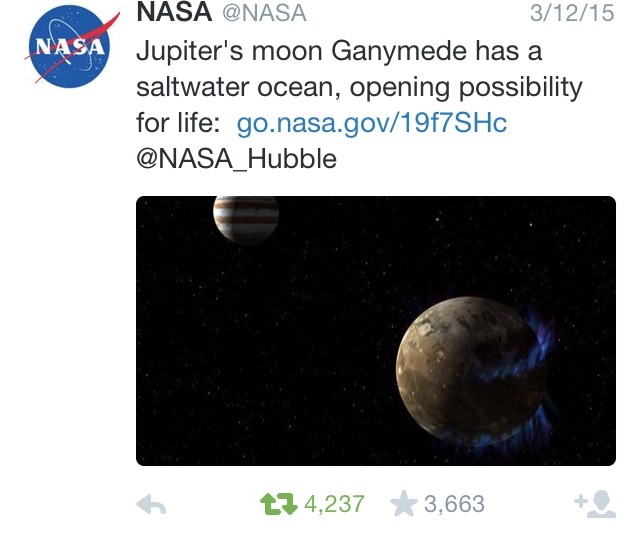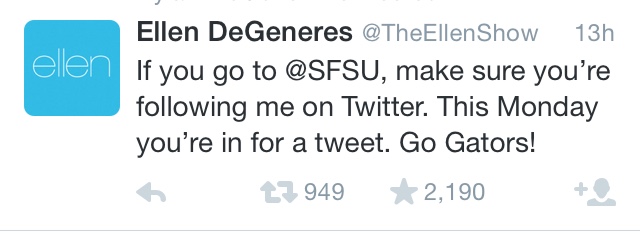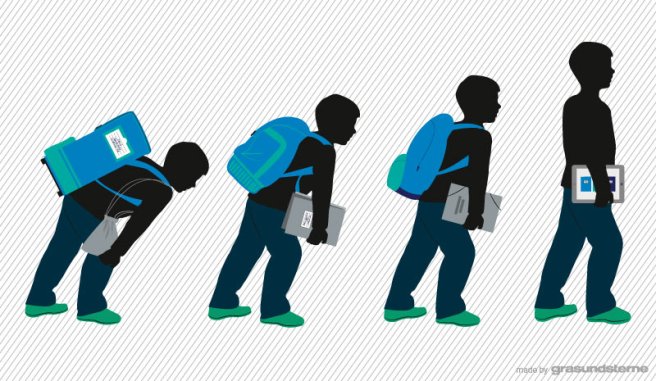
Digital learning is changing the face of education. The amount of new technology available to people of various incomes and ages is changing the way that people learn. Every year there is more technology available for use in classrooms. Elementary and middle school age children are being exposed to more computer labs and given tablets to help guide them in education. Educational applications for smartphones and tablets are being created for children as young as preschoolers. There are various forms of new technology being put out for educational purposes.
There is an increasingly popular debate happening between teachers and students. How does reading a book from a Kindle, IPad, or tablet of any sort compare with reading an actual textbook? Do we learn better now that we have unlimited access to the internet where we can find lots of information at any hour? Can we learn by using social media in classes? There is various research being done in order to find out what sort of impact using technology for education is having on people of all ages and how we can use it better.
Mobile learning has gained more interest from educational communities. The rise of literature on mobile devices is helping people learn more because it is easy to obtain and distribute information. Mobile devices are helping lower the costs of literature and in return making literature more accessible to everyone. Flashcard applications on tablets and their mobile devices are starting to have an impact on students of any age. The use of tablets in classrooms for the use of applications such as flashcards has impacted children’s learning in a positive way. Studies have shown Internet-enabled mobile devices can help students develop cognitive, mathematics, and language and literacy learning through the use of applications and game-based learning. (Min, L., Navarrete, C. C., & Wivagg, J., 2014)
There are several studies that report on kids’ average hours of screen time per day. The average is 2.2 to 4.6 hours for children ages 2- to 5. Studies show that babies are born hard wired to learn. Children who grow up in a world with a multitude of devices in their life have certain learning characteristics. These include: taking initiative, acting on their curiosity, making clear choices, trying different approaches, sticks to one task, and they seek social interaction. Most studies seem to indicate that children’s learning behaviors reflect a strong and positive attitude about the educational value of digital devices among most parents. The problems with using technology for early childhood learning is that many times the digital versions of the experiences are “right-answer oriented.” This means that instead of allowing the child to play and learn by exploring, the device acts as a game that requires straight forward answers and limits the open-ended play children need. (Gass, 2013) The table below shows the results of a survey given to parents about when and why their children use their tablets most. (Falkner, K., 2014)

A study was conducted in Hong Kong where digital classrooms were created in order to see what impact digital learning would have on students. A total of 107 students were invited from a secondary school to participate in the study. In the 13-week trial teaching, three students shared a Tablet PC for learning two topics in the Humanities subject. The pre- and post-tests of the two subjects found that the students had a statistically significant growth in domain knowledge and in information literacy competency and critical thinking skills. Table 11 below captures student’s evaluation of their learning through the use of the mobile devices. The results were overall very positive. Some problems with the device geared learning included: not enough time being given to complete the work, and that it did not allow for open ended questions and discussions. (Siu Cheung, K., 2014)

Digital learning also offers surprising advantages even for students with access to the best educational resources. Digital technologies are really good at teaching content. Testing indicated that many students do not come away from lectures ready to apply the concepts that were aimed to be taught. In contrast, students taught through online exercises that include immediate practices and feedback and reinforcement from teachers retained the concepts better and were better prepared to put them into practice. (Reif, L. R., & MIT, o., 2013)
Students in another study were asked to name three features they used most often and found most helpful on their mobile devices during the school year. The most popular answers were: accessing Internet, listening to music, and using the calculator. These features were found to be used most often around midschool year and at the end-school year as resource tools. Voice recorders, video cameras, and notes features on their devices were used most often for media creation tools for school related projects. In the table shown below an average of how much time the students spent on each feature was composited for the mid-school period and the end of school year period. (Min, L., Navarrete, C. C., & Wivagg, J., 2014)

Of those forms of technology, students said the most helpful when it comes to mobile technology based learning is in the form of an interactive textbook or e-textbook. The benefits of using a digital textbook according to the participants of a survey are that they make lessons easier to understand, they help complete assignments more quickly, and they help them stay more organized.
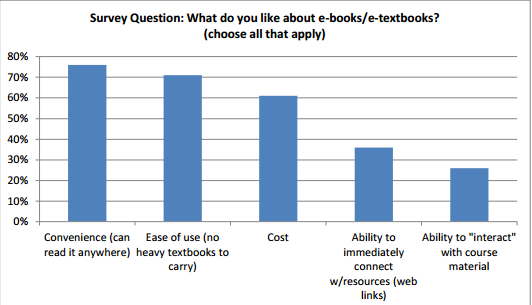
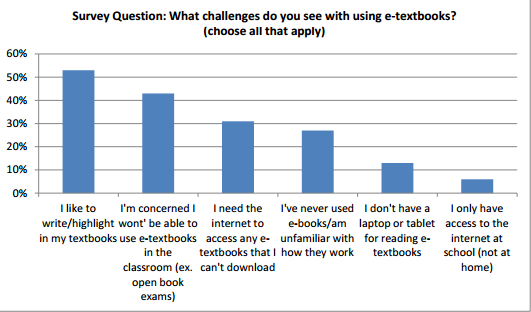
(The Minnesota State University Student Association, Inc., 2012)
Nearly eight out of ten students from that same survey also stated that they’ve had instructors ask them to use at least one social media site. The most popular social media sites being used for education are: YouTube, Facebook, and Twitter. (Survey, 2014) Apart from using social media for personal use, it is also being used in education as a way to exchange ideas among teachers, students and parents. Various social media sites exist and can be used for personal and educational purposes. There is a wide range of YouTube videos that have been specifically designed for different grade levels. Google Moderator is an online tool that lets students submit questions and vote for the ones they would most like answered. Through Facebook you can set up a page for a class where you can post homework assignments, share classroom information and begin a classroom discussion. (Heatley, E. R., & Lattimer, T. R., 2013) Although social media is starting to play a larger role in education, unfortunately many schools or districts still block social media sites. The one drawback of using social media for educational purposes is that there is a probability that it will distract students if they use it as a personal account.
The research done for digital learning is helping transform classrooms across the country. In 2012, more than 700 bills related to digital learning were debated in state legislatures. Of those bills proposed, 152 were signed into law that allows students to take classes online, equips students and teachers with mobile devices, and provides schools with the flexibility to embrace blended learning models. Ash, K. (2013).
Blended learning classrooms are popping up more in education. Studies have found that digital learning is beneficial for students of all ages. In some cases digital learning was found to be more beneficial than traditional forms of learning. Some studies showed that despite these advantages, digital learning is best used in combination of traditional learning because it helps leave room for open ended discussions. Learning through digital devices can limit the amount of educational exploration a student can do because frequently in applications for learning there is only straight forward answers that do not allow for further discussion.
References
Ash, K. (2013). Educational Technology. Education Week, 32(27), 5.
Falkner, K. (2014, August 6). Kids and Tablets – are your kids using tablets too much? Retrieved April 11, 2015, from http://blog.spamfighter.com/general/kids-and-tablets.html
Gass, S. (2013). How to Choose the Right Apps for Early Learning. The Journal, 40 (9), 20-22. Heatley, E. R., & Lattimer, T. R. (2013). Using Social Media to Enhance Student Learning. Techniques: Connecting Education & Careers, 88(1), 8-9.
Min, L., Navarrete, C. C., & Wivagg, J. (2014). Potentials of Mobile Technology for K-12 Education: An Investigation of iPod touch Use for English Language Learners in the United States. Journal Of Educational Technology & Society, 17(2), 115-126.
Reif, L. R., & MIT, o. (2013). Online learning will make college cheaper. It will also make it better. Time, 182(15), 54.
Siu Cheung, K. (2014). Developing information literacy and critical thinking skills through domain knowledge learning in digital classrooms: An experience of practicing flipped classroom strategy. Computers & Education, 78160-173. doi:10.1016/j.compedu.2014.05.009
Survey: Digital Textbooks Gaining Esteem in Student Eyes. (2014). Distance Education Report, 18(20), 7-8.
Textbook Survey Report. (2012, July 1). Retrieved April 11, 2015, from http://www.msusa.org/vertical/sites/{8F60E86D-EE41-444E-926B-0493E70B13F9}/uploads/Textbook_Survey_Report.pdf
 I did not fully understand how to use it the first time I made one. I didn’t find Twitter to be very useful or entertaining.
I did not fully understand how to use it the first time I made one. I didn’t find Twitter to be very useful or entertaining.